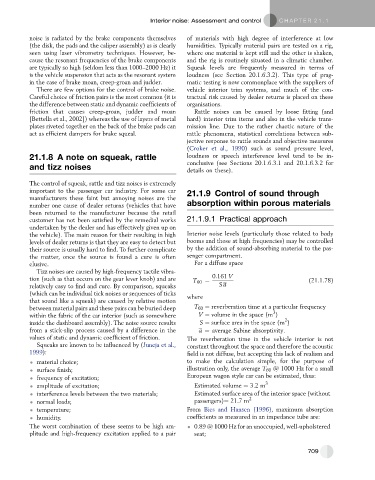Page 698 - Automotive Engineering Powertrain Chassis System and Vehicle Body
P. 698
Interior noise: Assessment and control C HAPTER 21.1
noise is radiated by the brake components themselves of materials with high degree of interference at low
(the disk, the pads and the caliper assembly) as is clearly humidities. Typically material pairs are tested on a rig,
seen using laser vibrometry techniques. However, be- where one material is kept still and the other is shaken,
cause the resonant frequencies of the brake components and the rig is routinely situated in a climatic chamber.
are typically so high (seldom less than 1000–2000 Hz) it Squeak levels are frequently measured in terms of
is the vehicle suspension that acts as the resonant system loudness (see Section 20.1.6.3.2). This type of prag-
in the case of brake moan, creep-groan and judder. matic testing is now commonplace with the suppliers of
There are few options for the control of brake noise. vehicle interior trim systems, and much of the con-
Careful choice of friction pairs is the most common (it is tractual risk caused by dealer returns is placed on these
the difference between static and dynamic coefficients of organisations.
friction that causes creep-groan, judder and moan Rattle noises can be caused by loose fitting (and
[Bettella et al., 2002]) whereas the use of layers of metal hard) interior trim items and also in the vehicle trans-
plates riveted together on the back of the brake pads can mission line. Due to the rather chaotic nature of the
act as efficient dampers for brake squeal. rattle phenomena, statistical correlations between sub-
jective response to rattle sounds and objective measures
(Croker et al., 1990) such as sound pressure level,
21.1.8 A note on squeak, rattle loudness or speech interference level tend to be in-
conclusive (see Sections 20.1.6.3.1 and 20.1.6.3.2 for
and tizz noises details on these).
The control of squeak, rattle and tizz noises is extremely
important to the passenger car industry. For some car 21.1.9 Control of sound through
manufacturers these faint but annoying noises are the
number one cause of dealer returns (vehicles that have absorption within porous materials
been returned to the manufacturer because the retail
customer has not been satisfied by the remedial works 21.1.9.1 Practical approach
undertaken by the dealer and has effectively given up on
the vehicle). The main reason for their resulting in high Interior noise levels (particularly those related to body
levels of dealer returns is that they are easy to detect but booms and those at high frequencies) may be controlled
their source is usually hard to find. To further complicate by the addition of sound-absorbing material to the pas-
the matter, once the source is found a cure is often senger compartment.
elusive. For a diffuse space
Tizz noises are caused by high-frequency tactile vibra-
tion (such as that occurs on the gear lever knob) and are T 60 ¼ 0:161 V (21.1.78)
relatively easy to find and cure. By comparison, squeaks S a
(which can be individual tick noises or sequences of ticks where
that sound like a squeak) are caused by relative motion
between material pairs and these pairs can be buried deep T 60 ¼ reverberation time at a particular frequency
3
within the fabric of the car interior (such as somewhere V ¼ volume in the space (m )
2
inside the dashboard assembly). The noise source results S ¼ surface area in the space (m )
from a stick-slip process caused by a difference in the a ¼ average Sabine absorptivity.
values of static and dynamic coefficient of friction. The reverberation time in the vehicle interior is not
Squeaks are known to be influenced by (Juneja et al., constant throughout the space and therefore the acoustic
1999): field is not diffuse, but accepting this lack of realism and
material choice; to make the calculation simple, for the purpose of
surface finish; illustration only, the average T 60 @ 1000 Hz for a small
frequency of excitation; European wagon style car can be estimated, thus:
amplitude of excitation; Estimated volume ¼ 3.2 m 3
interference levels between the two materials; Estimated surface area of the interior space (without
normal loads; passengers)¼ 21.7 m 2
temperature; From Bies and Hansen (1996), maximum absorption
humidity. coefficients as measured in an impedance tube are:
The worst combination of these seems to be high am- 0.89 @ 1000 Hz for an unoccupied, well-upholstered
plitude and high-frequency excitation applied to a pair seat;
709

